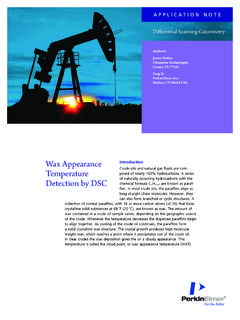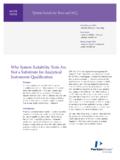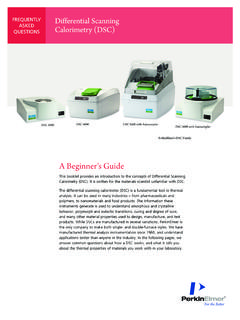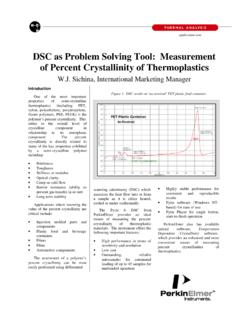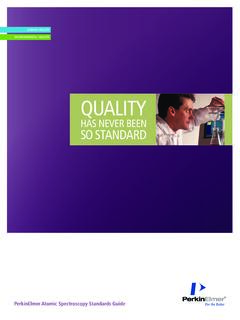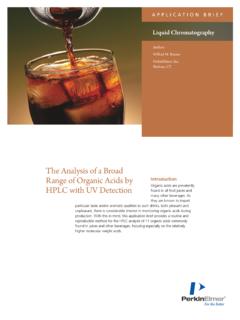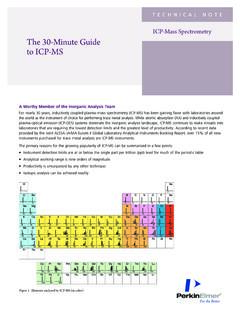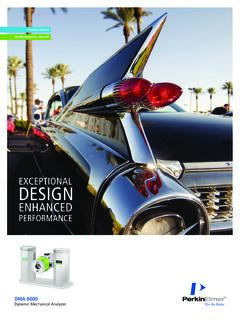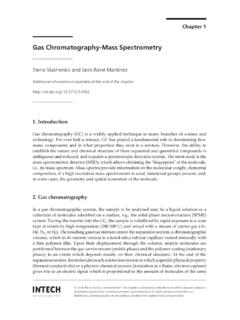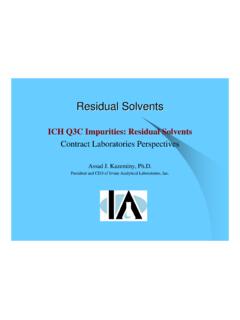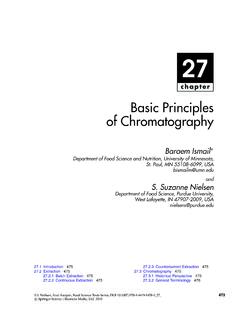Transcription of An Introduction To Headspace Sampling In Gas ...
1 AN Introduction TO Headspace Sampling IN GAS CHROMATOGRAPHYFUNDAMENTALS AND THEORY Andrew TiplerChromatography Research and Technology Manager perkinelmer , Inc. 2 Introduction 3 Fundamental Theory of Equilibrium Headspace Sampling 3 Volatile Analytes in a Complex Sample 3 Partition Coefficients 4 Phase Ratio 5 Vapor Pressures and Dalton s Law 6 Raoult s Law 7 Activity Coefficients 7 Henry s law 8 Putting It All Together 9 Effect of Sample Volume 9 Effect of Temperature 10 Effect of
2 Pressure 11 Effect of Modifying the Sample Matrix 12 Effect of the Equilibration Time 12 Specialized HS Injection Techniques 13 The Total Vaporization Technique 13 The Full Evaporation Technique 14 Multiple Headspace Extraction 15 Transferring the Headspace Vapor to the GC Column 17 Injection Time and Volume 17 Manual Syringe Injection 18 Automated Gas Syringe Injection 18 Valve Loop Injection 20 Pressure Balanced Sampling 20 Direct Connection 20 Split Injector Interface 22 Split Injector Interface with Zero Dilution Liner (ZDL) 23 Improving Detection Limits 24 Sample Stacking On Column 24 On-Column Cryofocusing 25 Dynamic Headspace Sampling 26 Headspace Trap Sampling 27 solid Phase microextraction (SPME)
3 30 Conclusion 33 References 33 Glossary 34 Table of ContentsAn Introduction to Headspace Sampling in Gas Introduction to Headspace Sampling in Gas ChromatographyIntroductionThis document is intended to provide the newcomer to Headspace Sampling with a concise summary of the theory and principles of this exciting technique.
4 Enough information is included here for the user to understand the basic concepts and relationships in HS Sampling to apply during method development and interpretation of data. Although emphasis is given to the perkinelmer TurboMatrix HS systems, the document also covers alternative systems so that it should be useful to all potential users of HS systems. It is not intended to be a comprehensive review of the subject and the reader is directed to an excellent book on this subject by Bruno Kolb and Leslie S. Ettre entitled Static Headspace -Gas chromatography [1].
5 This book is available for purchase from perkinelmer under the part number: Theory of Equilibrium Headspace Sampling Volatile Analytes in a Complex SampleHeadspace Sampling is essentially a separation technique in which volatile material may be extracted from a heavier sample matrix and injected into a gas chromatograph for analysis. To appreciate the principle, let s consider an application that is well suited for Headspace Sampling : perfume. The composition of perfume may be highly complex containing water, alcohol, essential oils etc.
6 If we inject such a sample directly into a typical GC injector and column, we get the chromatogram shown in Figure 1. A lot of time may be wasted in producing this chromatogram by eluting compounds that we have no interest in. Furthermore, many of these compounds may not be suited to gas chromatography and will gradually contaminate the system or even react with the stationary phase in the column so their presence is unwelcome. If we put a sample of this perfume into a sealed vial and heat it to a moderate temperature (say 60 C) for a period of time, what happens to the various molecules in the perfume inside the vial?
7 Consider Figure 2. The more volatile compounds will tend to move into the gas phase (or Headspace ) above the perfume sample. The more volatile the compound, the more concentrated it will be in the Headspace . Conversely, the less volatile (and more GC-unfriendly) components that represent the bulk of the sample will tend to remain in the liquid phase. Thus a fairly crude separation has been achieved. If we can extract some of the Headspace vapor and inject it into a gas chromatograph, there will far less of the less-volatile material entering the GC column making the chromatography Figure 1.
8 Chromatogram from direct injection of a perfume 3. chromatography of a perfume sample with Headspace Sampling . Figure 2. Movement of perfume molecules within a sealed and heated cleaner, easier and faster. A Headspace Sampling system automates this process by extracting a small volume of the Headspace vapor from the vial and transferring it to the GC column. Figure 3 shows a chromatogram produced from a Headspace sample taken from the same sample of perfume that produced Figure Introduction to Headspace Sampling in Gas ChromatographyPartition CoefficientsThe previous description is simplified.
9 In practice, the migration of compounds into the Headspace phase does not just depend on their volatility but more on their affinity for the original sample phase. Furthermore, if the contents inside the sample vial are left long enough, the relative concentrations of a compound between the two phases will reach a steady value (or equilibrium). For every compound, there is a thermodynamic energy associated with its presence in the Headspace phase and in the liquid phase. These thermodynamic properties dictate how the molecules will ultimately distribute themselves between the two phases .
10 The most convenient way of representing this distribution is through the partition coefficient (also known as the distribution ratio), partition coefficient is proportional to the ratio of the concentration of molecules between the two phases when at equilibrium as shown in Equation 1. Where:K is the partition coefficient of a given compound between sample (liquid) phase and the gas ( Headspace ) phase CS is the concentration of that compound in the sample (liquid) phaseCG is the concentration of that compound in the gas ( Headspace ) phaseK =CSCGNote that compounds with a high value for K will favor the liquid phase whereas compounds with a low K will favor the Headspace phase.
